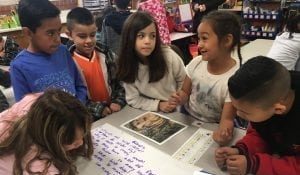The QFT is easy to use, fun, and adaptable. You can use it for any subject and with kids of any age. It gives kids a serious brain workout without the traditional teacher-student dynamic—making it a tool all parents should have in their homeschooling toolkit.
How do you keep your child’s learning on track when school is closed for weeks and you’re not a professional educator?
It’s a question parents and guardians around the country have been asking as communities respond to the COVID-19 virus with school shutdowns.
One activity worth trying is the Question Formulation Technique, known in education circles as the QFT. Created by the Right Question Institute, the QFT gives kids the opportunity to steer their own learning. It relies on kids’ curiosity and their own questions, which can make it a fun activity for parents, too.
The QFT is easy to use and adaptable. You can use it for any subject matter and with kids of all ages. You don’t need specific knowledge at your fingertips to use the QFT and create a joyful and meaningful learning experience for kids.
A book about the QFT, Make Just One Change: Teach Students to Ask Their Own Questions, is one of Harvard Education Press’ all-time top sellers. The technique used in schools to achieve a wide range of learning goals, but at home it can be a fun family activity for everyone. It’s something the family can do together as a break from screen time or as a project that uses online resources.
What is the Question Formulation Technique?
So, what is the QFT?
It’s a process through which kids (or adults) ask as many questions as they can, improve their questions, prioritize them, strategize on how to use them, and reflect on what they’ve learned.
The novel idea in using the QFT is that we, as teacher or parent, simply present a focus for the child to start asking questions about. Traditionally, it’s the teacher who asks questions in an effort to stimulate children’s thinking. With the QFT, children stimulate their own thinking with their own questions. It’s a simple change, but a profoundly important one. Something magical happens when, instead of following our questions, children get to ask their own.
Through this process, kids are able to flex their curiosity muscles, thinking broadly and widely about a topic and generating productive questions about it—sometimes profound or original questions that teachers have never thought of.
Then, kids are invited to focus. They work to make their questions better, and they eventually use those questions for further learning activities. In a school setting, questions often serve as the basis for age-appropriate research projects, essays, or scientific investigations. Children are also given the chance to think about what they’ve learned and how they learned it, which builds good study skills.
In the hands of an experienced teacher, the QFT can support a wide range of nuanced learning goals. For parents and guardians new to homeschooling, it can be a way to get a lot of learning mileage from one simple activity.
Get started with the QFT: videos and guides
The best way to get started is to watch one of the instructional videos at the Right Question Institute’s website. Each video is about nine to 12 minutes long:
Next, create and collect the things you’ll need:
- QFT worksheet: Download the “QFT Outline – Student Worksheet.” Print it up, use it as your guide, and use it to write down questions. (The Right Question Institute is a nonprofit organization, and resources on its website are free.)
- A Question Focus: This is a prompt that gets kids asking questions. It’s often a cool scientific phenomenon or image. Titles of books or videos often make quick and easy Question Focus material. There’s only one rule: The Question Focus can’t be a question.
- A next step: Think about what age-appropriate activity you want your kids to do with their questions. For instance, they could use them to do an online research project, go on a nature hunt, or draw a picture.
Don’t feel the need to go overboard. Keep it simple. Find an interesting image or YouTube video and use it as a Question Focus. The more you use the QFT, the more ideas you’ll develop about how to get the most out of it.
Tips for parents
The situation in every household is different. Some caregivers are interested in creating a structured homeschooling experience. For others, it’s important to maintain normal and relaxed family relationships.
Here are some tips for parents who want to keep things more relaxed:
- Have fun
- Parents can be facilitators but also participants
- Kids can also come up with a Question Focus
- Sibling dynamics may matter, but stick to the rules for asking questions
- Older kids could eventually work on their own
- If parents are too busy to explore the questions after doing the QFT, the children could become the teacher and search for different answers.
If you want to take the QFT to the next level, visit the Right Question Institute’s educational resources page to find additional guides and ideas.
About the author: Chris Orchard is senior communications associate at the Right Question Institute. Email him at chris.orchard@rightquestion.org.
